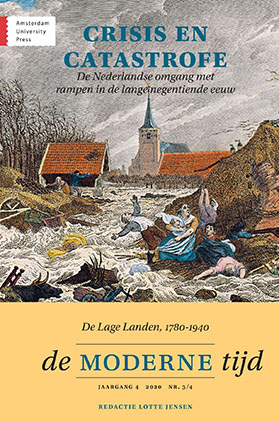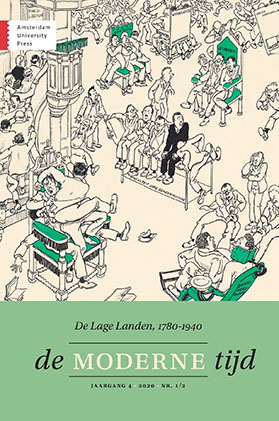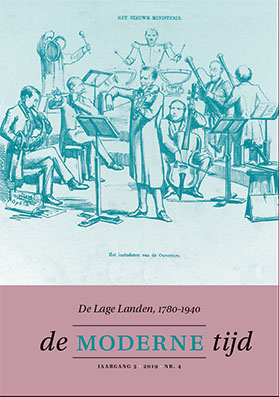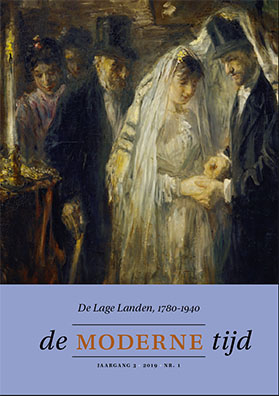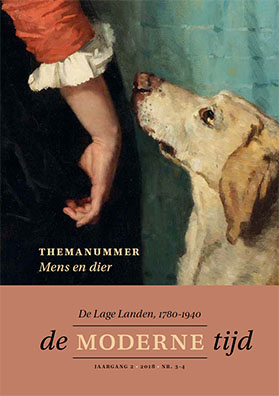Anneloek Scholten & Sophie van Os ‘Gij moet de heidegrond ontginnen. De Maatschappij van Weldadigheid en de cultivering van de bodem in de negentiende-eeuwse pers’ 251-267
https://doi.org/10.5117/DMT2021.3/4.002.SCHO
https://doi.org/10.5117/DMT2021.3/4.002.SCHO
Abstract (EN)
‘You Must Cultivate the Heathland’ In the nineteenth century, debates surrounding the cultivation of Dutch soil and processes of civilisation were inextricably linked. This article examines the discourse surrounding cultivation of heathlands in newspaper reports about the Society of Benevolence in the 1820s and 1840s. It considers the way the cultivation of heathland in Drenthe is framed as a civilizing force and reflects on the tensions between nation and region in reporting on this issue, as local economic and cultural interests conflicted with nationalist visions of progress and the interests of urban investors. Comparing Dutch and British reports on the Society, the article also forms a starting point for a transnational perspective on this topic.
Tom Sintobin & Marguérite Corporaal‘Turf is nu eenmaal een vruchtbaar terrein voor de fantasie’. De literaire verbeelding van veen en veenderij in Nederlandse literatuur, 1909-194027-50
https://doi.org/10.5117/DMT2021.3/4.003.SINT
https://doi.org/10.5117/DMT2021.3/4.003.SINT
Abstract (EN)
‘After all peat is a fertile soil for the imagination’. The literary representation of bog and peat cutting in Dutch literature, 1909-1940 Novels about peat lands and turf-cutting were immensely popular in the Netherlands during the first decades of the twentieth century. This article traces recurring narratives and tropes in four such novels written by H.H.J.Maas, Antoon Coolen, Anne de Vries, and Theun de Vries, illustrating the ambivalent role that peat lands play in these texts. They function as sites of communality, future opportunity, and disorder on the one hand, and as places of exploitation and alienation on the other. These four novels do not downright reject the introduction of industrial innovations, but some among them are critical of the class divisions that may result. Others seem to acknowledge the hard labour that turf production involves, but do not criticize the social status of the peat-cutters.
Lesley Penné & Arvi SeppDe verbeelding van moeras en veen. Figuraties van de drassige bodem als topos van de gemeenschap in de hedendaagse Duitstalig-Belgische literatuur292-310
https://doi.org/10.5117/DMT2021.3/4.004.PENN
https://doi.org/10.5117/DMT2021.3/4.004.PENN
Abstract (EN)
The Representation of Marsh and Bog. Figurations of the Marshy Soil as a Topos of Community in Contemporary German-Language Belgian Literature Literature from border regions is often characterised by a specific transcultural poetics that reflects the liminal as discourse and experience. In contemporary German-language prose from East Belgium (‘Ostbelgien’), the topological representation of swamp and moor occupies an important place. We will show how swamp and moor express the complex definition of national and regional identity of the German-language area in Belgium and become relevant topoi in regard to cultural memory. Literature can be seen as a privileged medium of criticism for expressing the pressures of the unspoken and the closed and for initiating intra-community public discussions. Through a cultural-historical analysis of the various figurations of bog and moor, we will examine how the relationship between landscape and community is represented and conceived in contemporary Germanophone Belgian literature.
Maarten MeijerCharles Liernurs pneumatische riool en het besturen van bodems311-327
https://doi.org/10.5117/DMT2021.3/4.004.PENN
https://doi.org/10.5117/DMT2021.3/4.004.PENN
Abstract (EN)
Charles Liernur’s Pneumatic Sewage System and the Governing of SoilsThis article interrogates the epistemological conditions of Charles Liernur’s pneumatic sewage system in order to shed light on the changing relation between soils and Dutch society in the nineteenth century. The first section discusses the relation between hygienism, soil and sewage. The second section unearths how Liernur’s design related to the agricultural chemistry of Justus Liebig. Through the epistemologies and the mediating technologies that are operationalized by hygienists and chemists, soils are made governable. The final section of this article discusses the struggle to commercialise the urban waste collected by Liernur’s system, highlighting the difference between governable and governed soils.
Lieske Tibbe Aardappeleters. Een laag-bij-de gronds thema in de schilderkunst, 1885-1905328-352
https://doi.org/10.5117/DMT2021.3/4.006.TIBB
https://doi.org/10.5117/DMT2021.3/4.006.TIBB
Abstract (EN)
Potato eaters. A mundane theme in painting, 1885-1905In late nineteenth-century Dutch art criticism, the topic of ‘poor people eating potatoes’ seems to have been a kind of litmus test for modern, Realist art. It was a sign of the dissolution of the hierachy of the genres, the decline of idealist painting with its elevated, literary themes, and it marked the emerging popularity of commonplace subjects without specific moral meaning attached to them. Likewise, painting of romantic, picturesque landscapes gave way to the more prosaic theme of hard work in the field. Poor farm workers at their shabby meal of potatoes, the fruits of their labour, were part of this subject matter. ‘Modern’ critics welcomed the shift in topics, ‘conservative’ ones fulminated against what they saw as a sign of decay. Catalogues of Exhibitions of Living Artists (Tentoonstellingen van Levende Meesters) and other expositions have been searched for paintings showing potato eaters, or related images like potato peeling, planting, digging, or potato still lifes. Quantitatively, these exhibitions did not justify the art critics’ rhetoric. Qualitatively, the critics’ aversion to the ‘potato eating’ theme was possibly related to its association with poverty and the imminent physical and moral decay of the lower class of the population. In modern realistic literature potato consumption also stood for degeneration. Partly outside the official art circuity, artists like Mauve, Witsen, Toorop, and especially Van Gogh showed potato production and consumption as ‘The Heroism of Daily Life’.
Michiel Purmer Op onvruchtbare bodem? Vroege natuurgebieden van Natuurmonumenten en het Nederlandse landschap353-376
https://doi.org/10.5117/DMT2021.3/4.007.PURM
https://doi.org/10.5117/DMT2021.3/4.007.PURM
Abstract (EN)
On barren soil? Early nature reserves of Natuurmonumenten and the Dutch landscapeIn 1905, Natuurmonumenten (Natural Monuments Society), a Dutch NGO for nature conservation, was founded. The society aimed to preserve some uncultivated lands, such as heathlands, fens, peat bogs but also forests, which were under threat of cultivation and reclamation. Natuurmonumenten managed to acquire a number of nature reserves in the years 1905-1940 for scientific, recreational and aesthetic reasons. In this article, this collection is analyzed and compared to the reserves of other Dutch nature conservation organizations in the same period. Although Natuurmonumenten acquired mainly barren soils, it turned out to be a fruitful start of a nature preservation organization that operated nationwide, and established a strong network within Dutch society.


